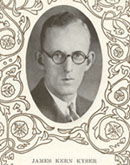
The accomplishments of North Carolina’s native son Kay Kyser have been well documented: UNC cheerleader, class president, and bandleader; host of the successful radio show Kay Kyser’s Kollege of Musical Knowledge from 1938 to 1949; big band leader with eleven number-one records to his name; star of seven feature films. Kyser’s rise to fame was swift, and he left an indelible mark on the Big Band era.
That’s all well and good, of course, but what did he wear to the beach?
The answer is our July Artifact of the Month.
When Kay Kyser headed to the shore, he used this red, white, green, and blue cap to shield his face from the sun. The cap’s exaggerated brim displays some of the characteristic whimsy for which Kyser was known throughout his show-biz career.
The hat also bears a U.S. Marine Corps insignia pin, but the only connection I could find between Kay Kyser and the military is his performance of a song called “Tell It to the Marines.” (If you know of something I’m missing, please chime in with a comment!)
Readers curious to learn more about the life of Kay Kyser can consult the papers of Kay and his wife, Georgia Carroll Kyser, which are in the Southern Historical Collection.
We’re thrilled to add this great piece of Kay Kyser memorabilia to the Gallery.


nice artifact! what yearbook is the photo from?
Perhaps Kay Kyser picked up the Marine Corps insignia pin during one of his numerous trips overseas to perform for troops during World War II.
Steven Beasley points out in his self-published biography of Kyser, Kay Kyser: The Ol’ Professor of Swing (http://search.lib.unc.edu/search?R=UNCb6036151), that the band leader was strongly committed to performing for the troops overseas. Beasley quotes an April 13, 1943 United Press report that suggests Kyser had made more than 1,100 appearances at military camps and sold nearly $400,000,000 worth of war bonds.
Beasley also notes that Kyser and his band were the first to perform on radio from a military installation. He writes that Kyser’s radio program was broadcast from a Marine base in San Diego on February 26, 1941.
Bob Hope, the man whom we most associate with performances for the troops, broadcast his first show from a military installation almost three months after Kyser’s program. The Hope show aired on May 6, 1941 from March Air Field in California.
Thanks for your comment, Taneya. The yearbook is UNC’s Yackety Yack.
This hat was given to my father by General Robert Eichelberger after he had been asked to come first to the Phillipines, then to many Pacific bases including one on the beach on Iwo Jima, to play for the troops under Eichelberger’s command. His letters to our mother on this subject written from the various bases there include very moving descriptions of conditions there at the very end of the war.
My sister and I only knew that hat as something funny that came out of the closet for a July 4th picnic or at the beach over the decades. We only recently became aware of why it meant so much to him.
Thanks, Amanda, for your illuminating comment! We’re so glad to finally know the meaning behind this mysterious hat.
Kay Kiser and Billy Arthur are often listed as UNC’s most famous cheerleaders, but most people don’t realize that organized cheering was begun at Carolina by Frank Porter Graham in 1914. According to a 1932 DTH article, Graham, a law student at the time, was a substitute baseball player and when he wasn’t needed on the field, he began to lead organized cheering. He was suceeded in this work the next year by Charlie Coggins who brought humor to the cheers. In 1917, Earl “Scrubby” Rives took cheerleading to a different level, becoming a campus celebrity of sorts. If this old newspaper article is correct, then next year is the 100th anniversary of cheerleading at Carolina.
Very interesting comment, Kevin. If I may, let me add two more names to your cheerleading list:
Leonard Victor (“Vic”) Huggins, who in 1924, introduced the first Rameses and Norman Sper, who in 1948, introduced the card section and victory bell.
This “View to Hugh” post from December, 2010, tells their stories:
http://blogs.lib.unc.edu/morton/index.php/2010/12/a-rambling-ram-and-a-traveling-trophy/
Here is another UNC cheerleading tidbit: “Cheerleader” was a campus elected office for a number of years. Students ran to lead cheers in the same campuswide elections in which DTH editors, class officers, and student body presidents were elected. Female cheerleaders were at first frowned upon. The first “coed” (meaning female) cheer leader was elected in 1948. In 1949, there were apparently two female cheerleaders, and some individuals in the state thought that they were being exploited. (Drum majorettes of the period wore the skimpy costumes, however, while the female cheerleaders wore more demure knee-length skirts.) See the DTH October 1, 1949.
Over the years, photographer Hugh Morton took many pictures of Carolina’s cheerleaders, several of which are in the Morton Online Collection…like the followings:
These from 1940
http://dc.lib.unc.edu/cdm/singleitem/collection/morton_highlights/id/5454/rec/4
http://dc.lib.unc.edu/cdm/singleitem/collection/morton_highlights/id/5484/rec/5
From 1941:
http://dc.lib.unc.edu/cdm/singleitem/collection/morton_highlights/id/5752/rec/8
http://dc.lib.unc.edu/cdm/singleitem/collection/morton_highlights/id/5549/rec/18
And from 1949 (This one appeared in the UNC vs. Wake Forest game program on October 15, 1949)
http://dc.lib.unc.edu/cdm/singleitem/collection/morton_highlights/id/7625/rec/9
Ish Kabibble (Merwyn Bogue), Kay’s comic foil in the band, received a cap just like Kay’s when they were performing together in the Pacific region. John Blythe-thanks for mentioning my book..we have an extensive Facebook page on Kyser under the book’s title. Full of rare photos, stories, songs, memorabilia, etc..
this is all well and good, but you’ve left out the most important piece of info. Where can i get a cap like that?